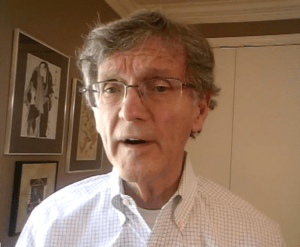As if churches didn’t have enough challenges in the 21st century, COVID-19 has added insult to injury, Bill Leonard told participants in the Cooperative Baptist Fellowship General Assembly June 26.
“COVID-19 is the most challenging threat to church life and human life that the country has seen since at least World War II,” said Leonard, founding dean and professor emeritus of Wake Forest University’s School of Divinity in Winston-Salem, N.C. Leonard also is a regular opinion columnist for Baptist News Global.

Bill Leonard address an online workshop during the CBF General Assembly June 26.
The challenges of a global pandemic have hit the church in the midst of numerical decline, diminished cultural influence, racism, the opioid crisis, debates over sexuality and many other challenges, he noted.
“Denominational systems are declining and fading,” Leonard reported. “Fewer individuals think of their primary religious identity as a denominational identity.”
On top of that, 4,000 or more churches close every year in America. And nondenominational and megachurches — while prominent and creating new models of church — only represent in their attendance about 8 percent of Americans who do attend church.
Overall, attendance at religious services has dropped from 50 percent to 35 percent of the population, Leonard said. Membership in religious communities has dropped from around 75 percent to 62 percent, and overall religious affiliation has moved from 95 percent to 75 percent of the population.
“Nones,” those Americans who do not identify with any church label, now account for 23 percent of the population — the same as evangelicals and Roman Catholics, he added, but with a caution on interpretation: “Nones often don’t understand themselves as atheists but rather as believers not belongers, spiritual but not religious.”
And one of the most important statistics to know, he said, is this: Seven in 10 white Christians in America are ages 65 or older.
All these things — with COVID-19 now thrown in the mix — are creating “ripple effects of declines in religious communities,” Leonard said. “As fewer and fewer people attend church, fewer and fewer networks of church-related institutions and participation are available or are known to those individuals.”
All is not lost, however, the historian added. Protestant churches may have lost their privileged status in America, but they have not lost the power of the gospel.
“Congregations now must be intentional about their identity,” he suggested. “In the past, denominations and denominational networks aided churches in identifying who they are and what they do.”
But no more, he explained, recommending that each congregation must be clear about what it does and why. To be successful in reaching their communities, those explanations should appeal to tradition but avoid dogmatism, he added. “Dogmatism can be a door that closes to those who may not understand.”
Likewise, leaders who are still asking whether their churches are growing numerically are asking the wrong question, Leonard asserted. “Begin by asking, ‘Is our church thriving?’ Are we energizing persons to do ministry through our faith community?’”
Churches should not expect people to come to their services and programs on the same schedule as the past, Leonard reported, citing what he called “the changing sociology of Sunday.” Soccer games, business events and family life all intrude on Sundays now more than ever before, he said, making Sunday a “difficult day for focusing only on churches.”
Just as churches ought to be intentional about their new schedules, they must be intentional about being local, he continued. “We must engage the community, not expect the community to find us. We have to go where there is need and make our case in terms of how we care for persons and our witness to the faith itself.”
Thriving churches today develop “signature ministries” that respond to specific local needs, he said. These become programs and ministries “by which they are known in a particular community.”
The big need, though, is for churches to tell “the Jesus story,” Leonard advised. “Churches must learn to revisit the Jesus story and how to tell that story in a way that creates a need and a response. We can take no details of the Jesus story for granted. We can’t assume people know the story.”
In the past, churches learned to begin the Jesus story with the appeal that each person “must be born again,” he said. But that message today “may not mean anything to people who are outside the church doors.” Instead, he advised starting with story of Jesus along the shore, calling people to follow him, saying, “The kingdom of heaven, God’s new day, has come among you. … God is with us. God is present now.”
